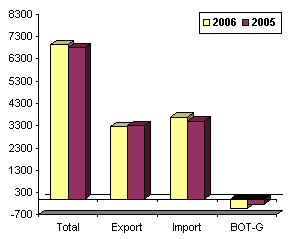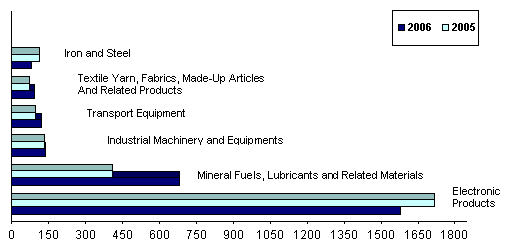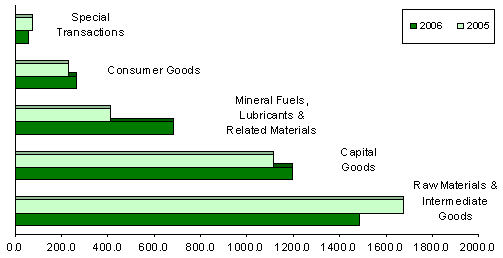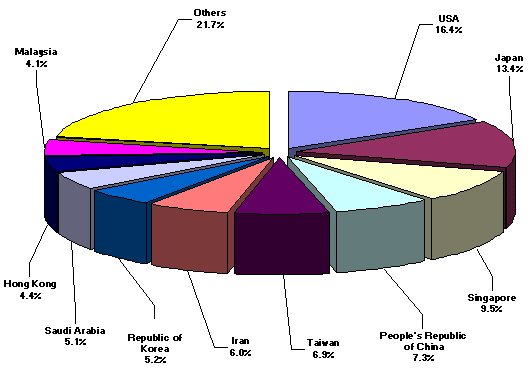External Trade Performance : January 2006 (Preliminary)
|
|||||||||||||||||||||||||||||||||||||||||||||||
r - revised
|
Top 10 Philippine Imports from All Countries: January 2006 |
|||
|
Gainers |
Losers |
||
|
Cereals and Cereal Preparations |
82.9 |
Iron and Steel |
-29.2 |
|
Mineral Fuels, Lubricants and Related Materials |
66.3 |
Electronic Products |
-7.9 |
|
Textile Yarn, Fabrics, Made-Up Articles and Related Products |
29.1 |
||
|
Transport Equipment |
24.9 |
||
|
Plastics in Primary and Non-Primary Forms |
19.0 |
||
|
Organic and Inorganic Chemical |
13.4 |
||
|
Industrial Machinery and Equipment |
2.8 |
||
|
Telecommunication Equipment and Electrical Machinery |
0.6 |
||
January total trade stands at $6.947 billion
Total external trade in goods for January 2006 amounted to $6.947 billion representing an increment of 2.2 percent from $6.796 billion during the same period of the previous year. On the other hand, exports registered a year-on-year negative growth of 0.9 percent to aggregate dollar revenue of $3.266 billion from $3.294 billion a year ago. Balance of trade in goods (BOT-G) deficit for the Philippines reached $415 million, higher compared to last year’s deficit of $207 million.
Figure 1. Philippine Trade Performance in January :2005 and 2006
(F.O.B. Value in Million US Dollar)

January imports register 5.1 percent increase
Total foreign-made merchandise went up by 5.1 percent to $3.681 billion from $3.501 billion. Compared to last month, total merchandise goods for January 2006 declined by 12.6 percent from $4.209 billion in December 2005. Dollar-inflow generated by exports amounted to $3.266 billion, or 14.7 percent lower than last month’s $3.827 billion.
Electronic products account for 42.9 percent of import bill
Accounting for 42.9 percent of the total aggregate import bill, payments for electronic products amounted to $1.580 billion or a 7.9 percent drop over last year’s figure of $1.716 billion. Compared to the previous month’s level, purchases fell by 24.0 percent from $2.078 billion.
Imports of mineral fuels, lubricants and related materials in January ranked second with 18.5 percent share. Expenditures at $681.11 million, posted a 66.3 percent growth over the previous year’s level of $409.69 million. This can be attributed to the higher demand in fuel and petroleum oils and oils from bituminous minerals.
Industrial machinery and equipment, the third top import was worth $138.74 million, or a rise of 2.8 percent from $134.96 million a year earlier. This was due to the high value of imports made on parts of machinery and mechanical appliances.
Transport equipment, contributing 3.3 percent of the total imports, ranked fourth as foreign bill amounted to $120.46 million from last year’s $96.48 million.The gain was mainly brought about by the 24.9 percent increase in the value of imports on passenger cars, components, parts and accessories and other parts of airplanes/helicopters.
Textile yarn, fabrics, made-up articles and related products, accounting 2.6 percent to the total bill, was RP’s fifth top import for the month with payments placed at $94.15 million from $72.94 million in January 2005. Higher value in the importation of fabrics for embroidery and knitted/crocheted fabrics mainly contributed the growth of 29.1 percent.
Expenditures for iron and steel, with a 2.2 percent share to the aggregate bill, went down by 29.2 percent to $80.18 million from $113.31 million in January 2005.
Rounding up the list of the top imports for January 2006 were organic and inorganic chemical , $76.23 million; plastics in primary and non-primary forms, $73.13 million;cereals and cereal preparations, $70.09 million; and telecommunication equipment and electrical machinery, $64.02 million.
Aggregate payment for the country’s top ten imports for January 2006 reached to $2.978 billion or 80.9 percent of the total bill.
Figure 2. Philippine Top Imports in January 2005 and 2006
(F.O.B. Value in Million US Dollar)

Raw materials and intermediate goods account for 40.3 percent of the total imports
Payments in January for raw materials and intermediate goods accounted for 40.3 percent as importation declined by 11.3 percent to $1.485 billion from last year’s figure of $1.675 billion. Semi-processed raw materials got the biggest share with a 36.1 percent and valued at $1.330 billion.
Capital goods comprising 32.5 percent of the total imports moved up by 7.4 percent year-on-year to $1.195 billion from $1.113 billion. The principal share went to telecommunication equipment and electrical machinery with a 19.4 percent share of the total imports and billed at $715.26 million.
Expenditures for mineral fuels, lubricants and related materials accelerated by 66.2 percent to $681.10 million from $409.69 million during the same period of 2005.
Purchases of consumer goods, amounted to $265.29 million, an increase of 14.1 percent from $232.53 million in January 2005, while special transactions decreased by 23.7 percent to $54.67 million from $71.67 million.
Figure 3. Philippine Imports by Major Type of Goods in January: 2005 and 2006

United States corners 16.4 percent of january import bill
Imports from United States accounting for 16.4 percent of the total import bill, reduced by 10.6 percent to $602.36 million from $673.67 million during the same period of 2005. On the contrary, exports to United States amounted to $630.45 million yielding a two-way trade value of $1.233 billion and a trade surplus for RP placed at $28.09 million.
Japan, the country’s second biggest source of imports for January with a 13.4 percent share, reported shipments billed at $491.57 million against exports earnings of $524.04 million. Total trade amounted to $1.016 billion, with a trade surplus registered at $32.47 million.
Singapore followed as the third biggest source of imports. With payments worth $349.75 million, imports grew by 43.2 percent from $244.24 million, while revenue from RP’s exports reached $241.81 million resulting to a total trade value of $591.56 million and a $107.94 million deficit for Philippines.
Other major sources of imports for the month of January were People’s Republic of China, $267.43 million; Taiwan, $254.87 million; Iran, $219.77 million; Republic of Korea, $191.71 million; Saudi Arabia, $187.43 million; Hong Kong, $163.97 million; and Malaysia, $150.05 million.
Payments for imports from the top ten sources for the month amounted to $2.879 billion or 78.2 percent of the total.
Figure 4. Philippine Imports by Country in January: 2006

Technical Notes
Adjustments on electronics import statistics are based on approved valuation methodology as per NSCB Resolution No. 8 Series of 2005.
|
(Sgd.) CARMELITA N. ERICTA |
Source: National Statistics Office
Manila, Philippines
